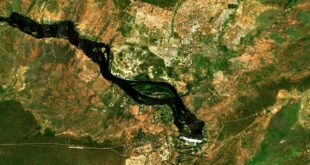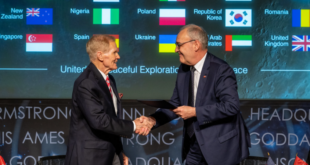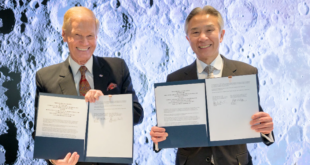 We know that there is a future beyond our planet, and today there are private companies that are striving towards making humanity’s journey to the Moon and beyond as sustainable as possible. One of these companies is Astrobotic. The Pittsburgh-based company is developing two lunar landers that will eventually fly payloads to space on a regular basis, an essential service for the establishment of human presence beyond our planet. SpaceWatch.Globals Editor-in-Chief Helen Jameson spoke to John Thornton, CEO, Astrobotic, to discover more about the company, its roots and its progress as it looks forward to its maiden mission.
We know that there is a future beyond our planet, and today there are private companies that are striving towards making humanity’s journey to the Moon and beyond as sustainable as possible. One of these companies is Astrobotic. The Pittsburgh-based company is developing two lunar landers that will eventually fly payloads to space on a regular basis, an essential service for the establishment of human presence beyond our planet. SpaceWatch.Globals Editor-in-Chief Helen Jameson spoke to John Thornton, CEO, Astrobotic, to discover more about the company, its roots and its progress as it looks forward to its maiden mission.
Can we begin with the genesis of Astrobotic? Why was the company formed and what is the vision?
We started Astrobotic twelve years ago. It was a spin-out of Carnegie-Mellon, and originally it was to compete for the Google Lunar XPrize. Of course, the XPrize ended without a winner. About 6 or 7 years ago, when I took over, we re-focused on the business of lunar payload delivery. Since then, we have been building the business and customer pipeline to show the world that we’re ready to go and we’ve been booking customers and growing since.
Can you give us more information on your two lunar landers, Griffin and Peregrine? What is the status of their development?
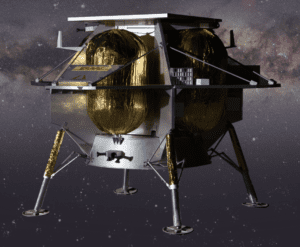
Peregrine is our flagship lander for the first mission. It can take up to 265kg to the surface of the Moon but for the first mission, we are just going to start with 35kg and an allotment set aside for a NASA payload. That mission will go in 2021. The Griffin lander is about twice the size of Peregrine and it will carry 400 to 500kg to the surface of the Moon and it is basically twice as capable. However, the core avionics are the same as Peregrine. It’s a family of spacecraft that we’re building
Do you expect to expand to larger landers in the future even though it’s early days?
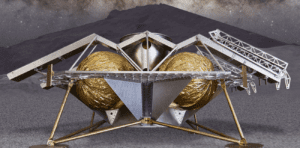
Eventually, yes. But Peregrine and Griffin are our focus for the foreseeable future. Going to the Moon takes a long time and it takes a while to develop these spacecraft. We obviously have the two landers and we also have rovers in development as well. That’s a full house there for us!
What kind of payloads do you hope they will deliver to the lunar surface? Do you have any commercial payloads?
Yes we have a whole array of payloads. We actually have 13 payloads that are all paying customers. We just announced another one last Monday. We were selected by a Toronto-based company, Canadensys Aerospace. They will fly a lunar science and technology payload that promotes Science, Technology, Engineering, and Math (STEM). We’ve got science instruments, we’ve got rovers, technology demonstrations, payloads that look at different infrastructure on the Moon – it’s a real mixture of payloads.
You expect your first mission to take place in 2021. Do you expect to make this target?
Yes, we expect to make our target of 2021. We are excited about our positioning right now. We’re looking forward to hearing from NASA as they are considering the first Commercial Lunar Payloads to be sent to the Moon, so we are looking forward to that.
What is the focus of Astrobotic’s business? Is it delivery of payloads, a focus on resources or infrastructure?

Over time, we expect that we will focus on all of these things. At its core, Astrobotic is a robotics company so we are first and foremost all about creating a robotic service delivery business to go to the Moon. But, over time, we will deliver other robotic service aspects such as rovers and then we will take a look at resources and the ways in which robotics can access them and make them available for other platforms like human landers and human satellites – but this will be deeper in time.
How frequently do you expect to carry out missions?
The first mission will be 2021. The second mission will probably be about 2 years after that. After that, we will be looking at a once a year cadence. We want to make sure that we can learn as much we can on the first mission and so any upgrades can be made as necessary for the second lander. Thereafter, it will be once a year.
This is quite a competitive business and new entrants are emerging on a regular basis. What are you unique selling points?
I think one of the biggest things is that there are two classes of landers being talked about right now. One is robotic landers on a small and medium scale which is what we do. Then, there’s the human scale landers which is what Blue Origin and many of the aerospace primes are looking at. They are orders of magnitude different from each other. It’s a huge difference in cost. Whereas robotic landers are routine and will take regular flights to the moon, human landers will be less frequent because of the expense and effort to put that together. So it’s really a system that works in concert. We think of companies like Blue Origin as a potential collaborator because there could be ways in which our landers can come together with their landers for surface missions.
Can you tell us more about CubeRover and why you chose Luxembourg as a base?
We have an update on this. We actually decided not to spin out to Luxembourg and we are keeping it State side. We found a lot of interest here in-country and decided that was the better pathway for the CubeRover programme.
How can you benefit from the Pence initiative to put boots on the ground on the Moon?
I think that, in general, the resurgence of interest in going back to the Moon is great for us. Anything that brings more attention to it such as human landings is a positive and it shows the world that the country is serious about it – and I think it will be the future for some time to come.
What can we expect from Astrobotic in the near future?
NASA will be selecting its first delivery supplier for its first delivery to the Moon and we’re very much hoping to be selected for that.
John Thornton has grown Astrobotic’s business of delivering affordable space robotics technology and planetary missions by attracting technology contracts, equity investment, and payload customers. Thornton is coordinating the team and alliance for Peregrine’s development and the first mission. At Carnegie Mellon, Thornton led the build of Scarab, a NASA concept robot for lunar drilling, and the first robot to carry a prototype of NASA’s RESOLVE payload. He founded Carnegie Mellon’s Advanced Composites Lab, a research, training, design, and manufacturing lab specializing in high performance, lightweight composites for robotics.


